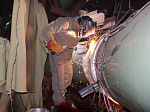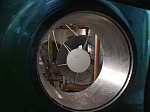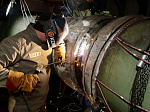29.01.2024
At the construction site of power unit No. 2 of the Kursk NPP-2, work began on welding the main circulation pipeline
The walls of the MCP are made of steel 7 cm thick, the total mass of pipelines and metal structures will exceed 250 tons
The main circulation pipeline (MCP) connects the main equipment of the primary circuit of the second power unit: the reactor vessel, steam generators and main circulation pumps. The technological process begins with the assembly of pipeline assemblies for welding, which is performed in accordance with the requirements of technical documentation.
“Strict requirements are imposed on the welded joints of the MCP, since the temperature of the primary circuit water at the outlet of the reactor will be 328 °C. Water circulation will be carried out under a pressure of 160 atmospheres, which is comparable to the pressure of water at a depth of about 1,600 meters. Welding of primary circuit pipelines is performed subject to certain conditions: ensuring a “clean” area for installation work, a special temperature regime (temperature not less than +10ºС), humidity - no more than 60% and a complete absence of drafts,” said Alexander Uvakin, director of the Kursk NPP.
Specialists of JSC Energospetsmontazh will manually perform 32 welded joints. The total weight of pipelines and metal structures will be more than 250 tons. The walls of the main circulation center are made of special steel with a thickness of 70 millimeters.
“MCP welding is a complex construction operation that includes several stages: preparation, welding, heat treatment, control and the final stage - austenitic surfacing. All work will be performed by highly qualified personnel,” commented Oleg Shperle, vice-president of Atomstroyexport JSC, project director for the construction of Kursk NPP-2.
The welding stage of the main circulation pipeline is a long and painstaking process; according to the plan, it takes 80 days.
For reference:
The Kursk NPP (Kurchatov, Kursk region) is one of the largest generating sources of electricity in the Central Russian Black Earth Region. The consumers of its electricity are 19 regions of the Center of Russia. The station includes three power units with channel reactors with a total capacity of 3 million kW. Power unit No. 1, after 45 years of service, has been in operating mode without generation since December 2021. The station's power units were connected to the country's unified energy system in 1976, 1979, 1983 and 1985. In 1994-2009, all operating power units underwent deep technical modernization. Over the years of operation, the Kursk nuclear power plant has generated over 1 trillion kWh of electricity. At the moment, the construction of power units No. 1 and No. 2 of the Kursk NPP-2 replacement station with a new type of PWR-TOI reactor is underway. Their design service life is 60 years with the possibility of extension for another 20 years.
The construction of power units No. 1 and No. 2 of the replacement station Kursk NPP-2 is carried out within the framework of the Federal project “Design and construction of reference power units of nuclear power plants” of the Comprehensive program “Development of equipment, technologies and scientific research in the sphere of use of atomic energy in the Russian Federation for the period until 2024.
The Russian nuclear industry has transformed from a piece manufacturer into a conveyor of nuclear technologies, a “reactor factory,” which allows Russia to occupy a leading position in the world in the export of nuclear technologies. Today, the share of power generated by nuclear power plants in Russia’s energy balance is about 20%, and by 2045 it should reach 25%. This instruction was given to the State Corporation Rosatom by the President of Russia.
The President and Government of the Russian Federation are expanding the range of measures to support domestic industry. The implementation of major projects, including in the energy sector, is accelerating. The Russian fuel and energy complex continues the planned renewal of capacities. This work is performed taking into account modern trends in digitalization and substitution of imported equipment. Rosatom and its enterprises take an active part in this work.




 career
career Innovations
Innovations Projects
Projects INTERNATIONAL BUSINESS
INTERNATIONAL BUSINESS